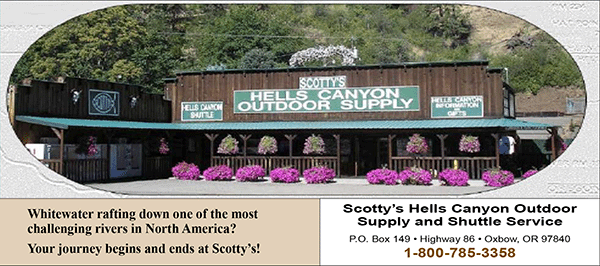A Trip Down the San Juan - 1950's
A Trip Down the San Juan
Written by Mary Lewis, ca. 1950s
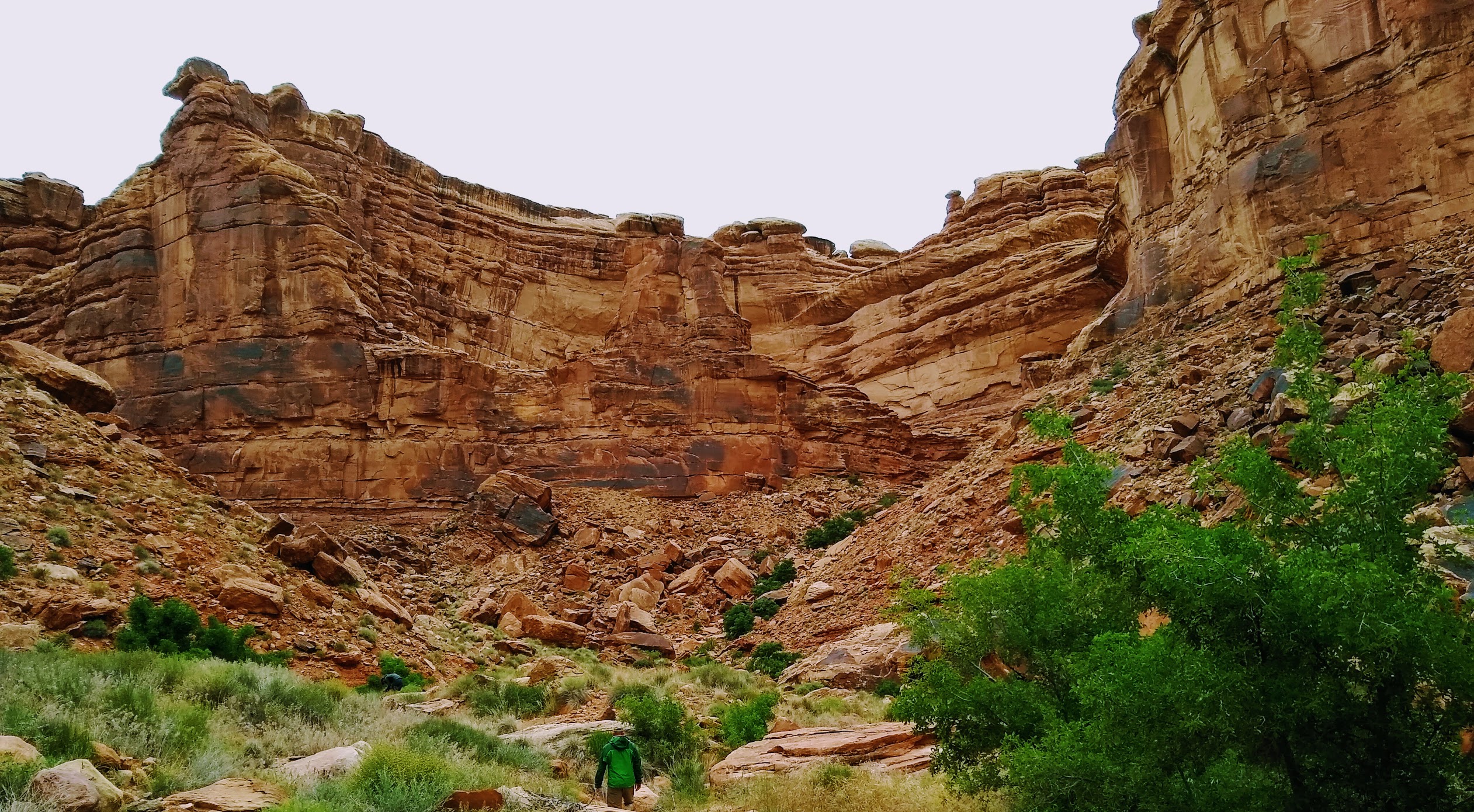 “How would you like to go down the San Juan River?”That question was at first mystifying to me as I had no idea what the San Juan meant or where it was. To those of you who know and love the Southwest, it would seem strange indeed to refuse. But at first I thought of it as so difficult an undertaking for any woman of my age that there seemed only one answer possible. But as I thought it over and especially when the printed descriptions began to come in giving glowing pictures of the relaxing and gentle nature of the whole episode, I thought perhaps I had made a great mistake. I would like to say now that relaxation was not a word I would ever employ in describing this trip. Eventually I sent in my name and began to look forward to June 12 and Mexican Hat, the starting point. Directions as to our personal equipment soon arrived and then followed a period of simplifying the first ideas and eliminating one garment after another until the final 15 lb. limit was reached. I read several books and articles on preceding trips and began to suspect I was embarking on 10 days of strenuous going rather than the reported idle days of drifting down a river.
“How would you like to go down the San Juan River?”That question was at first mystifying to me as I had no idea what the San Juan meant or where it was. To those of you who know and love the Southwest, it would seem strange indeed to refuse. But at first I thought of it as so difficult an undertaking for any woman of my age that there seemed only one answer possible. But as I thought it over and especially when the printed descriptions began to come in giving glowing pictures of the relaxing and gentle nature of the whole episode, I thought perhaps I had made a great mistake. I would like to say now that relaxation was not a word I would ever employ in describing this trip. Eventually I sent in my name and began to look forward to June 12 and Mexican Hat, the starting point. Directions as to our personal equipment soon arrived and then followed a period of simplifying the first ideas and eliminating one garment after another until the final 15 lb. limit was reached. I read several books and articles on preceding trips and began to suspect I was embarking on 10 days of strenuous going rather than the reported idle days of drifting down a river.
I discovered in the first few days that the San Juan was a tributary of the Colorado and that if there was not enough snow in the mountains behind, then the water would be low and we would have to “get out and push”. If there was plenty of snow and warm weather below, the water would be higher and swifter and some of the rapids might be impassible. I believe we hit a mean between the two possibilities.
I joined the first party of friends at Flagstaff from where we set out for three days of camping in Monument Valley prior to joining the main group. It was many years since I had camped and I looked forward to it with eagerness and some trepidation, fearing it might prove too difficult for me. But I need not have been afraid. Air mattresses have made sleeping a real pleasure, and there was no necessity of hunting for a soft spot. Any place that was level would do.
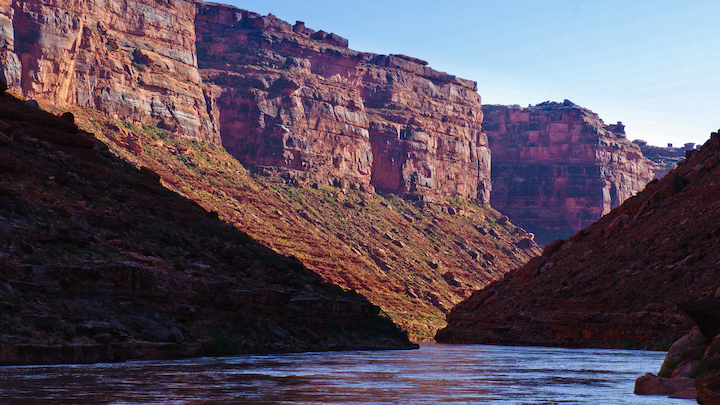 How can I convey the impression which Monument Valley made on me? I was totally unprepared for those strange red buttes of sandstone. We arrived at sunset at the foot of one of them, to look out over a valley below into the east, where more of these huge monuments were silhouetted against a pale mauve Sky. It was unbelievable and I felt like the man who said on first seeing a giraffe“There ain’t no such animal.”They were all of the Permian Period and in addition there were several volcanic necks startling in their sheer walls of black basalt and in their isolation in the flat surrounding plain. Strange to realize that all this plain had once been as high as the tops of these blocks and that by erosion of softer rock by wind and water, nothing was left of the original plateau but these queer red monuments. It seems impossible to convey even with pictures, any idea of it all.
How can I convey the impression which Monument Valley made on me? I was totally unprepared for those strange red buttes of sandstone. We arrived at sunset at the foot of one of them, to look out over a valley below into the east, where more of these huge monuments were silhouetted against a pale mauve Sky. It was unbelievable and I felt like the man who said on first seeing a giraffe“There ain’t no such animal.”They were all of the Permian Period and in addition there were several volcanic necks startling in their sheer walls of black basalt and in their isolation in the flat surrounding plain. Strange to realize that all this plain had once been as high as the tops of these blocks and that by erosion of softer rock by wind and water, nothing was left of the original plateau but these queer red monuments. It seems impossible to convey even with pictures, any idea of it all.
The days were hot but the nights delightfully cool so that we slept well. The roads too, were good and not as sandy and soft as we had been led to expect. Sunday afternoon, after watching for miles in the distance a huge gray monolcline of Permian Period sloping to the plain, we reached the San Juan River and drove down a narrow, rocky road to the suspension bridge over which we drove and which we were later to pass under in our boats. Then up on the other side to the lodge at Mexican Hat on a high plateau above the river. Here we met some of the party, more arriving in the evening and I felt our adventure was about to begin.
Mexican Hat in southeast Utah is a treeless bare Plateau with the lodge and one or two houses the only signs of habituation. Down by the river there was a trading post and the beach where our six boats were lying drawn up waiting to be loaded the next morning.
Our party of five found a wind swept hill above and behind the lodge to camp on and were preparing to go to bed after cooking dinner, when the leader of our party arrived and asked us to come down to the lodge to see some of the movies of the preceding year’s trip. More of the party had arrived and we met them all after the movie. They seemed to be from all over the country and a varied lot. Several of them had made the trip before and taken the pictures we saw. These confirmed my fears of a very strenuous trip. The general feeling was one of withdrawal from the group and a private speculation as to whether we were going to be able to live with each other for ten days. But as usually happens, we became very good friends before the trip was over.
Photos: Red Walls by Brian Wilson, Evening Light by Ben Nieves
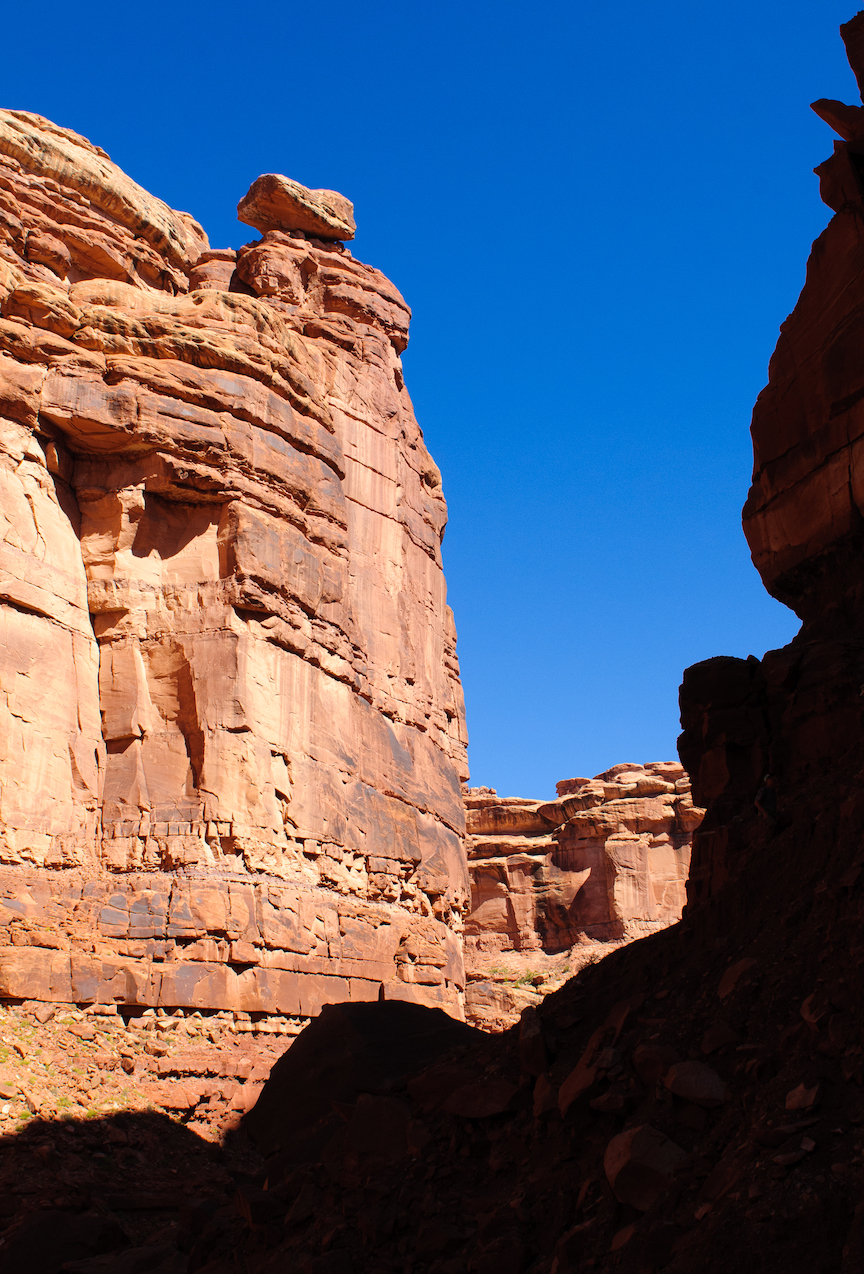 June 12 at last and the day we were to embark. Nothing seemed organized, several of the boatman were late in arriving and we hung around waiting, always a disagreeable procedure. But by noon the party were assembled on the beach and the loading was practically a fact. Our places were assigned, and shortly afterwards we set off. The photographers of the party were full of activity as the boats left. Each boat held three passengers and the boatman and luggage was stowed away under the big and small fore and aft decks. We drifted with the current under the big bridge and saw with interest not unmixed with horror, how much the bridge swayed and sagged when a big truck went over it. It was hot but not too hot and drifting slowly past the high cliffs and going through the famous Goose Necks was very easy enjoyment. Also listening to much talk on the geology of the country by our geologist. Most of the cliffs were of the Permian Period, Hermosa Formation, but in places topped by Rico Formation of Permian. They were sometimes as much as 1300 ft above us. We stopped for lunch at a sandy beach where some of us went bathing. Quite hot. The afternoon was much the same, pleasant drifting. By five we all went ashore on a large sandy beach where our party of 24 found plenty of room to camp in privacy if we so chose. Dinner the first night was somewhat in the nature of a banquet. Soup, chicken and ice cream with a huge pot of hot tea. The boatman did all of the cooking and loading of the boats. Before dinner we had time to explore the beach and found the rocks full of fossil shells (brachiopods and crinoid stems) almost impossible to extract, but very exciting to see.
June 12 at last and the day we were to embark. Nothing seemed organized, several of the boatman were late in arriving and we hung around waiting, always a disagreeable procedure. But by noon the party were assembled on the beach and the loading was practically a fact. Our places were assigned, and shortly afterwards we set off. The photographers of the party were full of activity as the boats left. Each boat held three passengers and the boatman and luggage was stowed away under the big and small fore and aft decks. We drifted with the current under the big bridge and saw with interest not unmixed with horror, how much the bridge swayed and sagged when a big truck went over it. It was hot but not too hot and drifting slowly past the high cliffs and going through the famous Goose Necks was very easy enjoyment. Also listening to much talk on the geology of the country by our geologist. Most of the cliffs were of the Permian Period, Hermosa Formation, but in places topped by Rico Formation of Permian. They were sometimes as much as 1300 ft above us. We stopped for lunch at a sandy beach where some of us went bathing. Quite hot. The afternoon was much the same, pleasant drifting. By five we all went ashore on a large sandy beach where our party of 24 found plenty of room to camp in privacy if we so chose. Dinner the first night was somewhat in the nature of a banquet. Soup, chicken and ice cream with a huge pot of hot tea. The boatman did all of the cooking and loading of the boats. Before dinner we had time to explore the beach and found the rocks full of fossil shells (brachiopods and crinoid stems) almost impossible to extract, but very exciting to see.
Next morning we got off to an early start about 7:30 after a plentiful breakfast. Not having camped for so many years I was not entirely prepared for sitting for long periods of time on a hard seat with no back. Meal time especially was at first difficult there being only rocks to sit on and an occasional stray bed roll, which everyone made for. It was a case of “first come, first served,” and woe betide you if you left a soft spot to get more food. You never got it back. There was always a line of eager beavers looking for your seat. This I only minded for the first few days. I soon got used to whatever offered and successfully withstood any of the small ailments which were circulating.
Our six boatmen did all of the work of camping and several had big voices and sang for us often. I shall never forget one morning coming back along a narrow stream, of which we had gone in the boats exploring. It was scarcely wide enough to use the oars, so that one of our men finally got out, tied the painter around his neck and strode down the stream singing the “Volga Boat Song” in a big resounding voice which echoed back and forth from these incredible high red walls.
Our second day was eventful with some rapids to be run. The first were gentle and scarcely noticeable to us. But when we approached Government Rapids the boats were beached and the rapids studied for some time from a high point. It was finally decided that anyone could go who desired, one passenger to a boat. The rest including the photographers, walked around, and the cameras were set up to get pictures of us as we came through. I found it exhilarating but not as rough as I thought. The rocks looked ugly but though we seemed to come very close to them, I gathered it was not really dangerous.
We stopped for lunch at a beach with the startling name of Slickhorn Gulch. It was hot of course and many of us went swimming. That is we were swept with the current down to a beach which caught us at a bend in the river. It gave one the illusion of being a strong and powerful swimmer so that we came out and did it over and over again with wild enthusiasm. After lunch we explored the steep trail back of the beach and found many fossil brachiopods and some beautiful large pieces of Jasper. It was hard to have to leave this place with a lovely pool in the enclosing rocks at the foot of the trail, but so hot that we longed to swim again. The fossils I found here were among the best I found anywhere on the river and very easy to pry out.
The afternoon was drifting through a calm stretch of river where some of the party got out their air mattresses and floated lazily past us. Some even walked down the middle of the stream, providing a strange spectacle in this wide and deceptively shallow river. It was a long day so we did not beach until 6 P.M. at Piute Farms. The walls had fallen away, the Hermosa formation having gone under and we had a wide prospect over low land.
Photos: Stone Towers by Ben Nieves
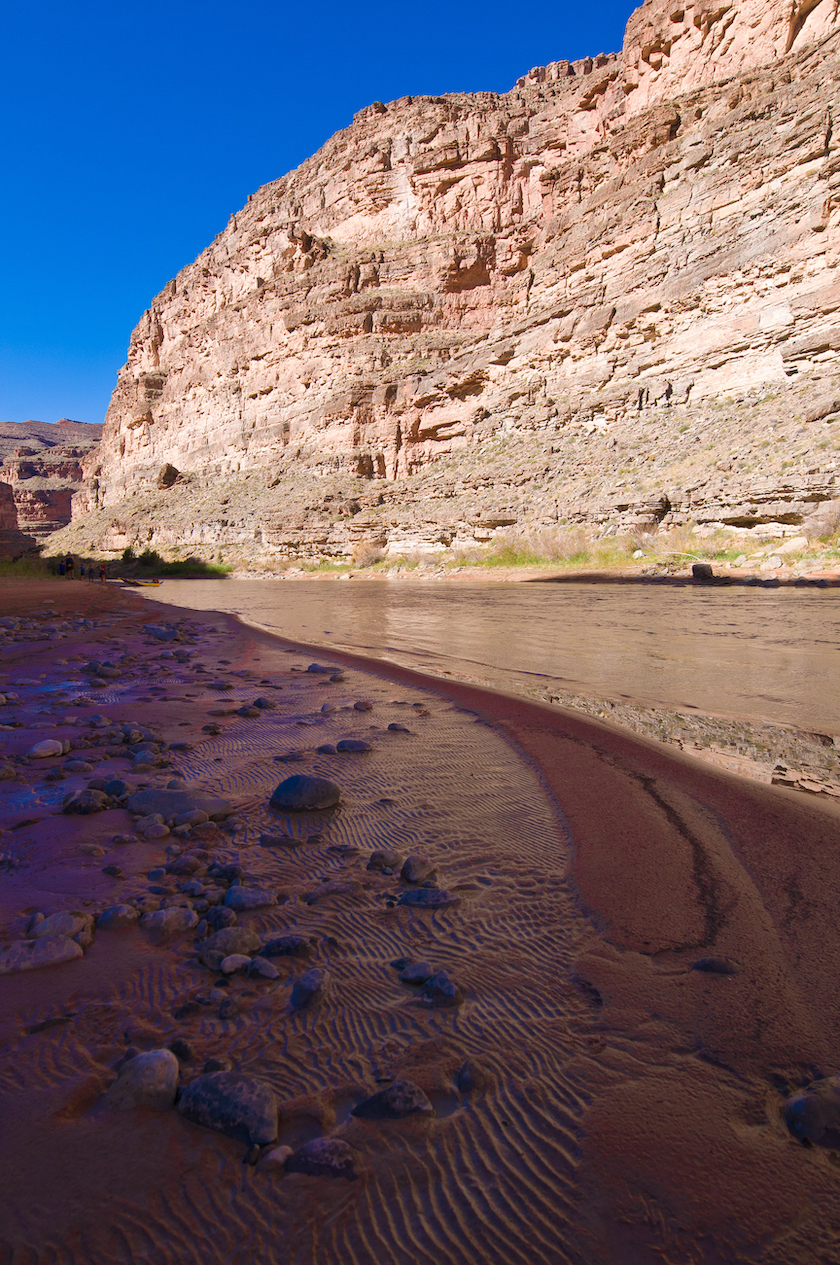 Our third day was quite different. This part of the river was very shallow and every few minutes our boat would stick on a shoal and all had to go overboard and push. Much of the bottom was treacherous with quicksand so that if we did not keep moving we sank to our knees. There were many amusing upsets but an exhausting day and I was very glad to see the end of this part of the river.
Our third day was quite different. This part of the river was very shallow and every few minutes our boat would stick on a shoal and all had to go overboard and push. Much of the bottom was treacherous with quicksand so that if we did not keep moving we sank to our knees. There were many amusing upsets but an exhausting day and I was very glad to see the end of this part of the river.
We slept that night at Clay Hill Crossing on a red sandy beach where the moonlight made the night wakeful and a long-tailed chat called us all early by his loud singing in the bushes against the red cliffs.
The fourth day and a day full of adventures. The 13 foot rapids were upon us early and had to be studied for as much as an hour when it was decided they were too dangerous for any but two of the most experienced boatmen. This meant that everything was thrown out on a muddy beach, bedrolls, boxes of food, canteens and jugs of water, mountains of bread, besides our personal bags. We all helped carry the seemingly endless supplies across hot, stony ground to the beach below the rapids. Then each boat entirely empty, was brought through to the cheers of those on the beach, the cameras clicking merrily at the same time. It was quite a dramatic scene for the rocks looked extremely jagged and the spray was high. The leader rowed his boat as easily as though he were rowing on a calm lake. The other was a handsome young dare devil who brought his boat through with a bit of dash and flair.
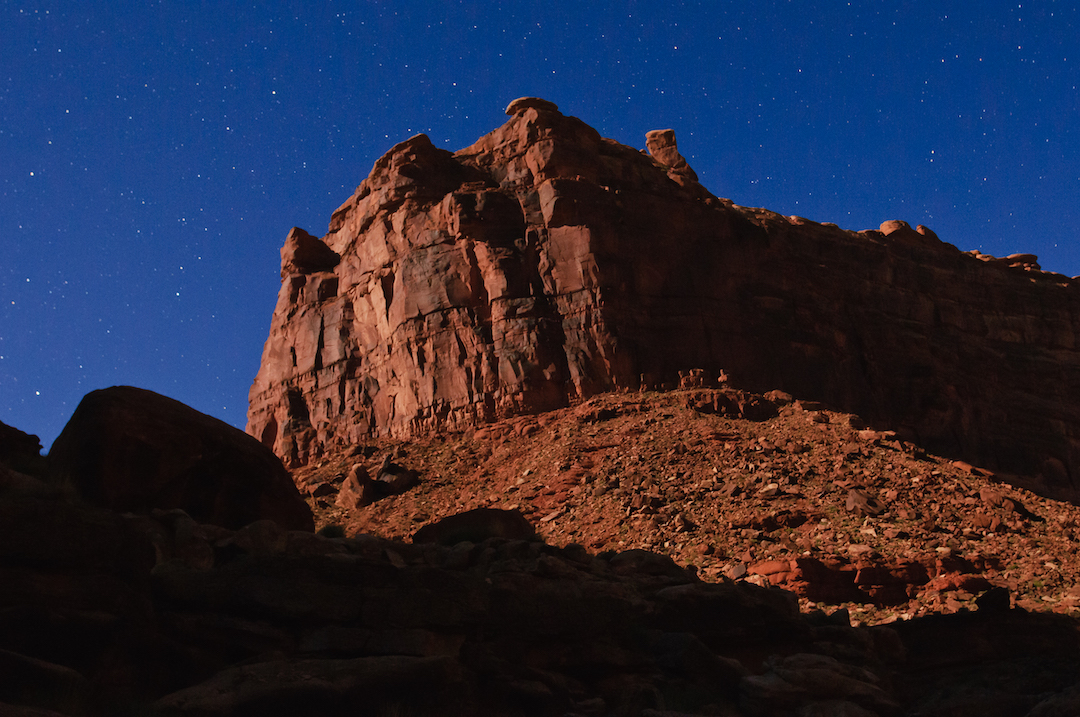 I thought we were to sleep here, but not at all. All the equipment had to be stowed away in its proper place and we took off again for our evening goal. And there then occurred our only near tragedy. Three of the party went ahead on air mattresses. We saw them pass us and vanish around a bend in the river. Suddenly
I thought we were to sleep here, but not at all. All the equipment had to be stowed away in its proper place and we took off again for our evening goal. And there then occurred our only near tragedy. Three of the party went ahead on air mattresses. We saw them pass us and vanish around a bend in the river. Suddenly
we became aware of a white object appearing and disappearing at the foot of an immense rock. It was obviously the white bathing cap of one of the girls and she seemed to be caught in a whirlpool at the foot of this rock. We all looked on helplessly and horror-stricken for what seemed an interminable time, when one of our boats in passing, set up a sort of counter wave, which released her and then another boat picked her up. She was knocked nearly senseless and seemed very dazed. I think the incident diminished the enthusiasm for the air mattress mode of travel for some days.
Photos: Mud Flat by Ben Nieves, Starry Night by Ben Nieves
The next morning, our fifth day, we walked up to the head of this canyon. A short but rough scramble over big boulders. But such a surprise awaited us at the end. In this dry and dusty country here was a circular red wall dripping incredibly with water and covered with maiden-hair fern, columbine and even some enchanting wild orchids. A lovely spot. Back at our bluff I found the Jimson weed had opened up too, with large white lily-like blossoms touched with lavender.
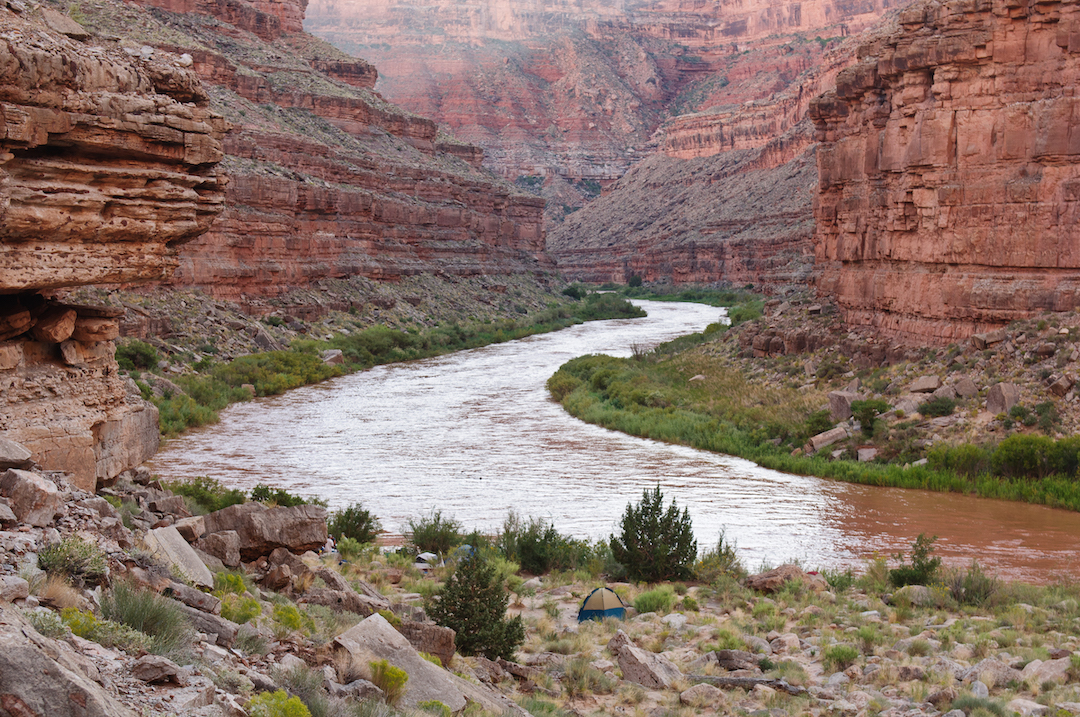 After leaving this green paradise we had only an hour left before gliding into the Colorado and leaving the San Juan for good, and its stupendous Navajo sandstone cliffs, in reds and pinks with extraordinary tracery on them of black weathering. Many of the photographers went on ahead and climbed a high bluff at the intersection of the two rivers, to catch the boats as we came through. The waters of the Colorado here seem quieter and deeper and the cliffs even higher.
After leaving this green paradise we had only an hour left before gliding into the Colorado and leaving the San Juan for good, and its stupendous Navajo sandstone cliffs, in reds and pinks with extraordinary tracery on them of black weathering. Many of the photographers went on ahead and climbed a high bluff at the intersection of the two rivers, to catch the boats as we came through. The waters of the Colorado here seem quieter and deeper and the cliffs even higher.
We stopped first at Hidden Passage, a long oval pass between the ever-present towering cliffs. They dwarfed our party as we walked along this beach, or lay on our backs at the foot of him. I felt how impossible it would be to convey to anyone unfamiliar with this type of country any idea of their majesty. So sheer, they were, so red, so different from any other place, so rarely visited. After this we crossed the Colorado and went into still another canyon called Music Temple. A circular amphitheater with a clear pool at the base. The names of Powell and others of his party inscribed on the wall. An extraordinary echoing vault with unusual acoustical effects, but vast and impressive. Each canyon has something of its own but all are alike in being utterly strange and foreign.
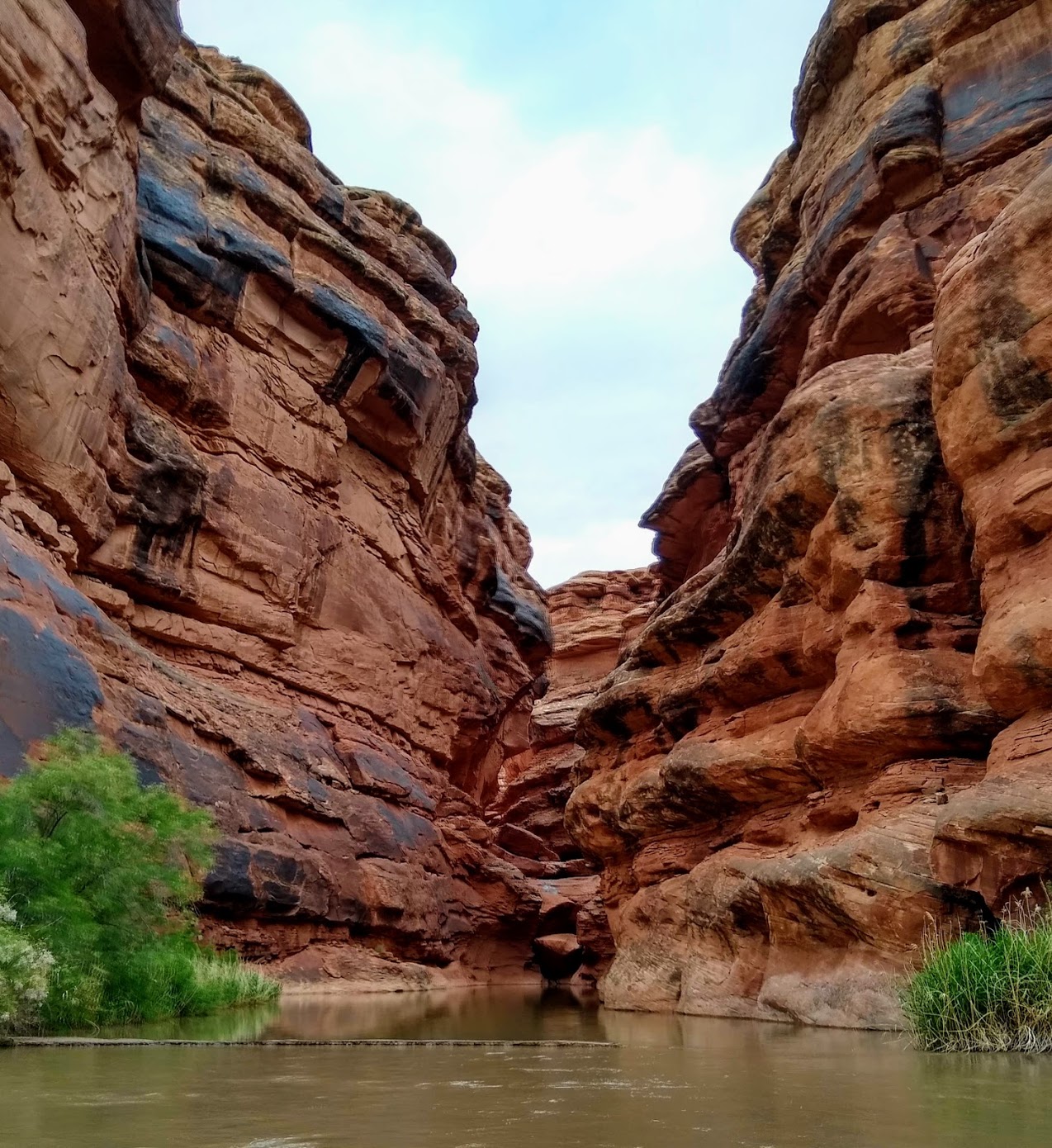 At about 5 P.M. we arrived at Forbidden Canyon where we camped on an open beach and were to start our trip to Rainbow Bridge the following morning. After dinner as several of us were preparing to fall thankfully into bed we were invited to walk around a bend into the canyon proper. Here on high ledges we sat down and listened to one of the boatmen read aloud stories from the first trip through these waters. Excerpts from the Stanton-Brown expedition were most eagerly listened to, making our comfortable trip seem easy and full of fun compared with the hardships encountered by the men who first explored the Colorado. What endurance and faith they must have had to continue! The moon came up over the rim and at the conclusion of the reading a voice was heard on the rim telling an Indian tale, which closed with a fire-fall down the cliff. The whole setting seemed so appropriate for these tales that we forgot weariness in wonder at the beauty of this spot.
At about 5 P.M. we arrived at Forbidden Canyon where we camped on an open beach and were to start our trip to Rainbow Bridge the following morning. After dinner as several of us were preparing to fall thankfully into bed we were invited to walk around a bend into the canyon proper. Here on high ledges we sat down and listened to one of the boatmen read aloud stories from the first trip through these waters. Excerpts from the Stanton-Brown expedition were most eagerly listened to, making our comfortable trip seem easy and full of fun compared with the hardships encountered by the men who first explored the Colorado. What endurance and faith they must have had to continue! The moon came up over the rim and at the conclusion of the reading a voice was heard on the rim telling an Indian tale, which closed with a fire-fall down the cliff. The whole setting seemed so appropriate for these tales that we forgot weariness in wonder at the beauty of this spot.
Next morning the horses and mules arrived for a two-hour trip up to Rainbow Bridge. Through these magnificent walls and over a very rocky and uneven ground we walked our horses and when we finally came around a curve and saw the bridge my first feeling was “What a tremendous arch. How much bigger it is in reality than all the pictures I’ve ever seen of it.” Especially was this so standing beneath it. It towered above us, seemingly much higher than its reputed 300 ft. Our camp was up and beyond it where we had no view of its splendor, a rather hot and unpleasant place, rendered so largely by man. The horses and mules came through the camp at night, wandering around our beds and I was glad to get back again the next morning to Forbidden Canyon in the high ledges with shade, where we ate lunch. But I shall never forget that gigantic bridge. We spent a hot afternoon waiting for the sun to set so that we could have an early dinner and start on our way in the cool of the evening. It was delightful floating down stream by moonlight, but by eleven we were all very glad to land at Rock Creek Bar, and fall hastily into bed.
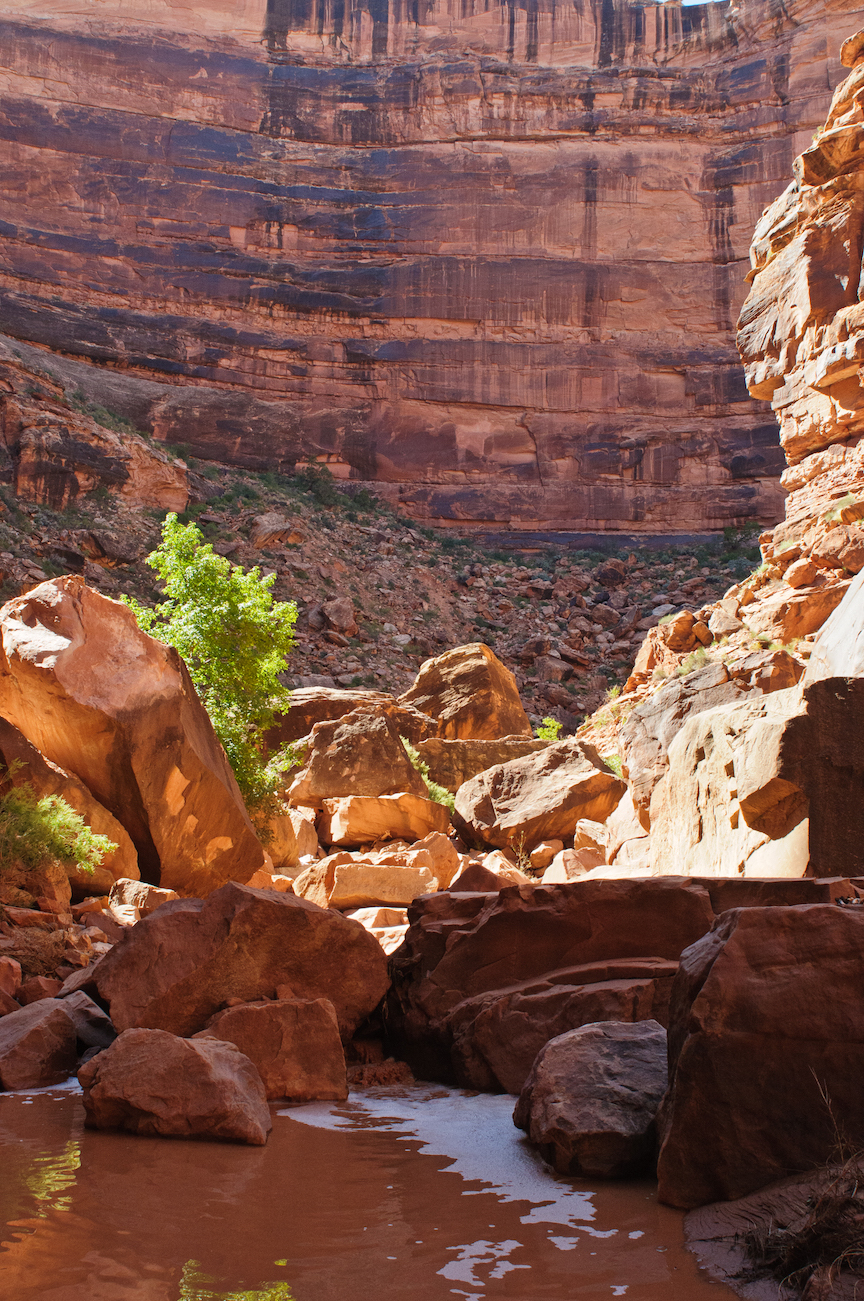 The eighth day and we have two more on the sick list. One boatman who has mysteriously come down with flu and has been doctored by nearly everyone in camp with all the heterogeneous drugs that seem to be available. Also one young man down with the prevalent stomach ailment which has had four or five victims to date. It doesn’t seem very serious, and so far I have escaped. The eighth day saw us camped at Cane Creek. Before dinner we walked overland to see the famous “Crossing of the Fathers” at Padre Creek, where father Escalante in November, 1776 brought his party on horseback and cut steps in the steep sandstone cliff down to the creek where they then crossed the Colorado. A truly remarkable feat.
The eighth day and we have two more on the sick list. One boatman who has mysteriously come down with flu and has been doctored by nearly everyone in camp with all the heterogeneous drugs that seem to be available. Also one young man down with the prevalent stomach ailment which has had four or five victims to date. It doesn’t seem very serious, and so far I have escaped. The eighth day saw us camped at Cane Creek. Before dinner we walked overland to see the famous “Crossing of the Fathers” at Padre Creek, where father Escalante in November, 1776 brought his party on horseback and cut steps in the steep sandstone cliff down to the creek where they then crossed the Colorado. A truly remarkable feat.
During dinner the sky clouded over and there was a threat of rain. The night was sultry and we were all concerned at the possibility that torrential rain might prevent our exploring the last and most extraordinary canyon. But the ninth day broke clear enough and it was decided that we could visit Labyrinth Canyon. A flash flood in such a canyon might have been disastrous. We took our boats up a narrow neck for about a quarter of a mile and then continued on foot through passageways, wagdin up to our waist part of the time. The higher we walked the more fabulous it became. The walls came together at one time and there seemed no possibility of penetrating further, but a glimmer of light above showed a few slippery rocks, and by dint of pulling and shoving, the weaker ones got through and we all stood in a wider place of high walls, solitary and silent. Hardly a bird, little vegetation and only one small rattlesnake which must have dropped from above so out of his element he seemed in this dark, damp spot. One of our party nearly stepped on him and the poor thing was killed by many brave spirits.
After this the walls came together again and the going was so difficult we had sometimes to walk sidewise. The rocks above being an unimaginable dark green and purple color and twisted into spiral shapes. Under foot it narrowed to a few inches and became darker and darker. This went on indefinitely so at length many of us turned back. I believe it came out into sun later. But altogether a most unusual experience. We returned to lunch covered with mud and slime but all agreed that Labyrinth canyon was a most exhilarating experience and the most bizarre of all that had been seen.
That night we reached Outlaw Cave, our last night on the river. This was an astounding arch of truly overwhelming proportions. Once used as a hideout for a runaway from justice. Hence the name. The men had built a fire in one small corner in a fire place from which Frank Lloyd Wright might well have drawn his ideas, so vast it was. Dinner over, the boys sang to us and we all fell onto bed rolls early and slept despite a gale of soft warm wind. Next day was clear and hot on the water, giving us all a last dose of sunburn. We reached Lee’s Ferry and were driven 16 miles to Art Greene’s place for lunch. Here the party gradually dispersed, by plane, truck and car and the most remarkable trip of my life was over.
Photos: Lazy Bend by Ben Nieves, Canyon Cliffs by Brian Wilson, High Point by Ben Nieves
In Appreciation
Thank you to Cinny Lewis Shaffer for sharing her grandmother’s story and a bit of her family history with OWA and to Lou Kustin for the idea and the connection to Cinny. Cinny was planning to go on vacation to Italy early next month to celebrate an important birthday. COVID-19 thwarted those plans. Now she just may be considering a different type of vacation, her first river trip, to float the same river her grandmother floated more than 60 years ago.
To read more about Gilbert N. Lewis, check out these resources: Hildebrand, Joel H. “Gilbert Newton Lewis 1875-1946.” Biographical Memoir, National Academy of Sciences, 1958, pp. 210–235. Retrieved from http://www.nasonline.org/publications/biographical-memoirs/memoir- pdfs/lewis-gilbert-n.pdf
Jensen, William B. “The Mystery of G. N. Lewis’ Missing Nobel Prize,”
First published in T. Strom, V. Mainz, Eds., The Posthumous Nobel Prize
in Chemistry: Correcting the Errors and Oversights of the Nobel Prize Committee, ACS Books: Washington, DC, 2017, pp. 107-120. Retrieved from http://www.che.uc.edu/jensen/W.%20B.%20Jensen/Reprints/The%20 Mystery%20of%20G.%20N.%20Lewis’%20Missing%20Nobel%20Prize.pdf
To learn more about Glen Canyon before and after the dam, check out this video:
A dam drowned Glen Canyon - but drought is revealing its wonders again: Filmmaker Taylor Graham kayaked through crannies of Glen Canyon that hadn’t been seen for decades. He tells us about the experience. https://www.nationalgeographic.com/environment/2018/12/glen- canyon-rediscovered-film-kayak-dam/#close

